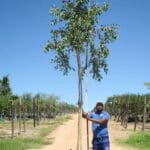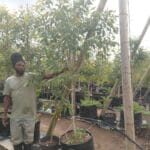Showing all 5 resultsSorted by latest
-

Syzygium Guineense 400lt
R8,950.00Add to cartSyzygium Guineense 400lt
Common Name: WaterpearFull Sun
Indigenous
Medium Watering
Wind TolerantSyzygium guineense, commonly known as Waterberry, Water Pear, or African Waterpear, is a species of tree belonging to the Myrtaceae family. It is native to various regions in Africa, including parts of West Africa, East Africa, and southern Africa. The Waterberry tree is valued for its edible fruits and is often found growing near water sources, such as rivers and lakes.
Appearance: Syzygium guineense is a medium-sized to large tree that can reach heights of 10 to 30m. It has a rounded crown with dense foliage.
Leaves: The leaves of the Waterberry tree are simple, opposite, and elliptical in shape. They are dark green and have a glossy appearance.
Flowers: The tree produces small, cream-colored or white flowers that are arranged in panicles or clusters. The flowers are usually not showy but are an important source of nectar for pollinators.
Fruits: The most significant feature of Syzygium guineense is its edible fruit, which is known as Waterberry or Water Pear. The fruits are small, round, and turn from green to purple-black when ripe. They have a sweet and slightly tart flavour and are enjoyed fresh or used to make jams, jellies, and beverages.
Growth Requirements: Waterberry trees prefer well-draining soil and are commonly found growing in areas with access to water, such as riverbanks and wetlands. They can tolerate both full sun and partial shade.
Uses: The fruits of Syzygium guineense are an important food source for both humans and wildlife, including birds and various mammal species. In some regions, the bark and leaves of the tree have also been used for medicinal purposes.
Wildlife Attraction: The Waterberry tree is attractive to birds and other wildlife, which feed on its fruits and disperse its seeds, contributing to its ecological significance.
-

Syzygium Guineense 200lt
R4,500.00Add to cartSyzygium Guineense 200lt
Common Name: WaterpearFull Sun
Indigenous
Medium Watering
Wind TolerantSyzygium guineense, commonly known as Waterberry, Water Pear, or African Waterpear, is a species of tree belonging to the Myrtaceae family. It is native to various regions in Africa, including parts of West Africa, East Africa, and southern Africa. The Waterberry tree is valued for its edible fruits and is often found growing near water sources, such as rivers and lakes.
Appearance: Syzygium guineense is a medium-sized to large tree that can reach heights of 10 to 30m. It has a rounded crown with dense foliage.
Leaves: The leaves of the Waterberry tree are simple, opposite, and elliptical in shape. They are dark green and have a glossy appearance.
Flowers: The tree produces small, cream-colored or white flowers that are arranged in panicles or clusters. The flowers are usually not showy but are an important source of nectar for pollinators.
Fruits: The most significant feature of Syzygium guineense is its edible fruit, which is known as Waterberry or Water Pear. The fruits are small, round, and turn from green to purple-black when ripe. They have a sweet and slightly tart flavour and are enjoyed fresh or used to make jams, jellies, and beverages.
Growth Requirements: Waterberry trees prefer well-draining soil and are commonly found growing in areas with access to water, such as riverbanks and wetlands. They can tolerate both full sun and partial shade.
Uses: The fruits of Syzygium guineense are an important food source for both humans and wildlife, including birds and various mammal species. In some regions, the bark and leaves of the tree have also been used for medicinal purposes.
Wildlife Attraction: The Waterberry tree is attractive to birds and other wildlife, which feed on its fruits and disperse its seeds, contributing to its ecological significance.
-

Syzygium Guineense 250lt
R8,395.00Add to cartSyzygium Guineense 250lt
Common Name: WaterpearApprox 4.5-5.5m
Full Sun
Indigenous
Medium Watering
Wind TolerantSyzygium guineense, commonly known as Waterberry, Water Pear, or African Waterpear, is a species of tree belonging to the Myrtaceae family. It is native to various regions in Africa, including parts of West Africa, East Africa, and southern Africa. The Waterberry tree is valued for its edible fruits and is often found growing near water sources, such as rivers and lakes.
Appearance: Syzygium guineense is a medium-sized to large tree that can reach heights of 10 to 30m. It has a rounded crown with dense foliage.
Leaves: The leaves of the Waterberry tree are simple, opposite, and elliptical in shape. They are dark green and have a glossy appearance.
Flowers: The tree produces small, cream-colored or white flowers that are arranged in panicles or clusters. The flowers are usually not showy but are an important source of nectar for pollinators.
Fruits: The most significant feature of Syzygium guineense is its edible fruit, which is known as Waterberry or Water Pear. The fruits are small, round, and turn from green to purple-black when ripe. They have a sweet and slightly tart flavour and are enjoyed fresh or used to make jams, jellies, and beverages.
Growth Requirements: Waterberry trees prefer well-draining soil and are commonly found growing in areas with access to water, such as riverbanks and wetlands. They can tolerate both full sun and partial shade.
Uses: The fruits of Syzygium guineense are an important food source for both humans and wildlife, including birds and various mammal species. In some regions, the bark and leaves of the tree have also been used for medicinal purposes.
Wildlife Attraction: The Waterberry tree is attractive to birds and other wildlife, which feed on its fruits and disperse its seeds, contributing to its ecological significance.
-

Syzygium Guineense 125lt Large
R4,290.00Add to cartSyzygium Guineense 125lt Large
Common Name: WaterpearApprox 3.5-4m
Full Sun
Indigenous
Medium Watering
Wind TolerantSyzygium guineense, commonly known as Waterberry, Water Pear, or African Waterpear, is a species of tree belonging to the Myrtaceae family. It is native to various regions in Africa, including parts of West Africa, East Africa, and southern Africa. The Waterberry tree is valued for its edible fruits and is often found growing near water sources, such as rivers and lakes.
Appearance: Syzygium guineense is a medium-sized to large tree that can reach heights of 10 to 30m. It has a rounded crown with dense foliage.
Leaves: The leaves of the Waterberry tree are simple, opposite, and elliptical in shape. They are dark green and have a glossy appearance.
Flowers: The tree produces small, cream-colored or white flowers that are arranged in panicles or clusters. The flowers are usually not showy but are an important source of nectar for pollinators.
Fruits: The most significant feature of Syzygium guineense is its edible fruit, which is known as Waterberry or Water Pear. The fruits are small, round, and turn from green to purple-black when ripe. They have a sweet and slightly tart flavour and are enjoyed fresh or used to make jams, jellies, and beverages.
Growth Requirements: Waterberry trees prefer well-draining soil and are commonly found growing in areas with access to water, such as riverbanks and wetlands. They can tolerate both full sun and partial shade.
Uses: The fruits of Syzygium guineense are an important food source for both humans and wildlife, including birds and various mammal species. In some regions, the bark and leaves of the tree have also been used for medicinal purposes.
Wildlife Attraction: The Waterberry tree is attractive to birds and other wildlife, which feed on its fruits and disperse its seeds, contributing to its ecological significance.
-
Sale!

Syzygium Guineense 125lt
Original price was: R4,290.00.R2,350.00Current price is: R2,350.00.Add to cartSyzygium Guineense 125lt
Common Name: WaterpearFull Sun
Indigenous
Medium Watering
Wind TolerantSyzygium guineense, commonly known as Waterberry, Water Pear, or African Waterpear, is a species of tree belonging to the Myrtaceae family. It is native to various regions in Africa, including parts of West Africa, East Africa, and southern Africa. The Waterberry tree is valued for its edible fruits and is often found growing near water sources, such as rivers and lakes.
Appearance: Syzygium guineense is a medium-sized to large tree that can reach heights of 10 to 30m. It has a rounded crown with dense foliage.
Leaves: The leaves of the Waterberry tree are simple, opposite, and elliptical in shape. They are dark green and have a glossy appearance.
Flowers: The tree produces small, cream-colored or white flowers that are arranged in panicles or clusters. The flowers are usually not showy but are an important source of nectar for pollinators.
Fruits: The most significant feature of Syzygium guineense is its edible fruit, which is known as Waterberry or Water Pear. The fruits are small, round, and turn from green to purple-black when ripe. They have a sweet and slightly tart flavour and are enjoyed fresh or used to make jams, jellies, and beverages.
Growth Requirements: Waterberry trees prefer well-draining soil and are commonly found growing in areas with access to water, such as riverbanks and wetlands. They can tolerate both full sun and partial shade.
Uses: The fruits of Syzygium guineense are an important food source for both humans and wildlife, including birds and various mammal species. In some regions, the bark and leaves of the tree have also been used for medicinal purposes.
Wildlife Attraction: The Waterberry tree is attractive to birds and other wildlife, which feed on its fruits and disperse its seeds, contributing to its ecological significance.
